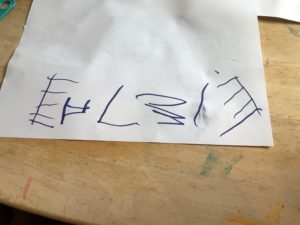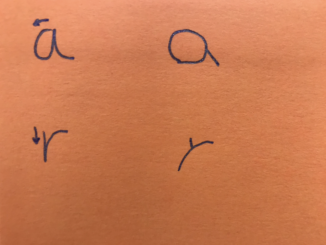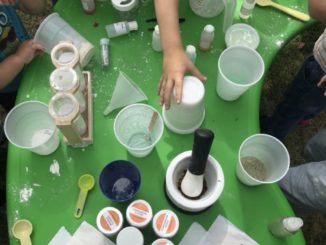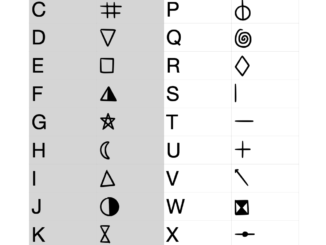My 4yo daughter told me that she wanted to “draw” my name.
She wanted this because she has seen me write things by hand. She finds it meaningful and personally interesting. She has also watched my son, who’s a year older than her and in compulsory school, be interested in writing — especially names — and she wants to be like him. She can read her own name when it is written, so she knows that names are a cool and important thing that can be read and written.
(All of these are exactly the types of reasons why four-year-olds should write if they find writing personally meaningful. And if they don’t find writing personally meaningful and cool and fun, then they shouldn’t be writing. None of these reasons are “because someone made her practice” or “because someone suggested she should”.)
(This is also applicable to 3 year olds and 5 year olds and even 6 year olds. I know that doesn’t fit with what schools require. It’s still developmentally true—unfortunately, schools don’t dictate how child development unfolds.)
She looked at me to tell her the first letter. I told her both the letter’s name and its sound — “Kay, ‘kuh’” — because she knows about half the letters by their names and about half of them by their sounds. (Also developmentally typical. It would also be typical if she didn’t know the letters and didn’t find them interesting or meaningful.)

With great focus and concentration, she wrote the “K” (which is the 2nd letter shown in the picture). She drew the up-and-down stroke of K. Then she made a horizontal line outward for the second stroke, instead of making a diagonal upward line. This is also perfectly developmentally typical. Drawing on the diagonal — like the lines of a triangle, a slash, / \, or the strokes of a K — is a step more advanced than horizontal and vertical lines (like — and |). That’s because in order to draw diagonally, you have to move your hand both horizontally and vertically but in the right proportion or ratio to one another to make a slope. It’s tricky! It’s also a skill that is required to write lots and lots of letters. Think about K, X, M, N, V, Y…all of these have diagonal lines as part of them.
(Yet frequently I watch preschool and kindergarten/kindy and reception classes where kids are required to write their names or trace their names before they know how to make all the pre-writing shapes, like diagonal lines. A recipe for frustration and feeling like they’re not good enough…when really they just aren’t developmentally ready yet.)
She realized that she wasn’t quite getting the diagonal and tried to rectify it with the 3rd stroke of the K she was drawing. She did this by accidentally drawing a corner and accidentally drawing it in the wrong direction! Her brain knew for sure that there was supposed to be something different about the line…it wasn’t just supposed to be horizontal…so she tried to make it go horizontal and vertical at the same time (to make it diagonal). But the brain directions to go “horizontal and vertical at the same time” instead came out as “horizontal, and then vertical,” causing her to make a corner instead.
Still perfectly developmentally normal. Still a part of learning.
She looked up expectantly and joyfully at me after having drawn this K. It’s not a recognisable K by any proper writing standards. It’s also exactly where she is supposed to be at 4. I smiled back at her equally joyfully and said “Awesome! The next letter is E, eh.”
She moved back to draw the E before the K, because left to right directionality of letters and words is not something that most 4 year olds have a great grasp of, which is—guess what I’m about to say—yep, perfectly developmentally typical. (It’s one of those arbitrary social things, which is why other languages can be written right to left, or top to bottom…because all that matters is that we all agree collectively what to expect from our language, but there’s no inherent law of the universe that left to right is How To Write. And most 4yos don’t have a great grasp on arbitrary social things yet. Including literacy-related ones.)
She drew an E with a bunch of lines, which is both adorable and perfectly developmentally typical. I adore “ladder Es”. It’s an early numeracy (math) skill to be able to count things that are in groups of 3 or more, and Es typically have 3 lines, but many kids’ brains early categorise that as being synonymous with just “a bunch of lines” before they can reliably count and reliably care about letter formation. So a bunch of lines it shall have.
I dictated the next letter for her, letter name and sound, “‘Ell’, ‘lll.’” (okay it’s hard to phonetically type L but I did it fine saying it out loud.) She drew an L. I said “The next letter is S, sss.” She drew a little squiggly tornado. This one was especially interesting to me, I’ve never seen her write an S! Her brain is clearly treating it similar to E. An E is “a bunch of lines” and an S is “a bunch of squiggles” but she wasn’t quite sure how many so she just made a few zigzags and called it good. Sharp points are sometimes easier to draw than soft curves.
The next letter was I, the only one she drew lowercase. (Also developmentally typical, are you tired of me saying that yet?) After all, the fun dot on top of an i is the only thing that makes it more interesting than just a regular ol’ line. Sometimes she draws /i/ with a big bubble for a dot which is also typical and super cute and what I did when I was 11 years old. If I was feeling extra-extra then I would even turn the bubble into a little cat face with ears and whiskers. 😉
The last letter was another E, which she drew similar to her first E but reversed. (Developmentally typical! Remember what I was saying about left-right being arbitrary? It’s the same with letters facing one way or the other.)
At no time did I correct or comment on a single one of her letters at all. I did not point to where to draw them on the page. I did not draw them as a model — not that that’s wrong, I do that sometimes, but I do know that copying from a model is a different skill than writing/drawing from your memory, and she was happy to write from memory this time and I wanted to see how it would go. I didn’t tell her anything was backwards. I didn’t tell her that my name is KELSiE not EKLSiE. I just sat and watched and told her how to spell it.
She finished drawing it and said, “Mom!!!! I drew your name!!!!!”
And I said, “You did!!!!!!”



